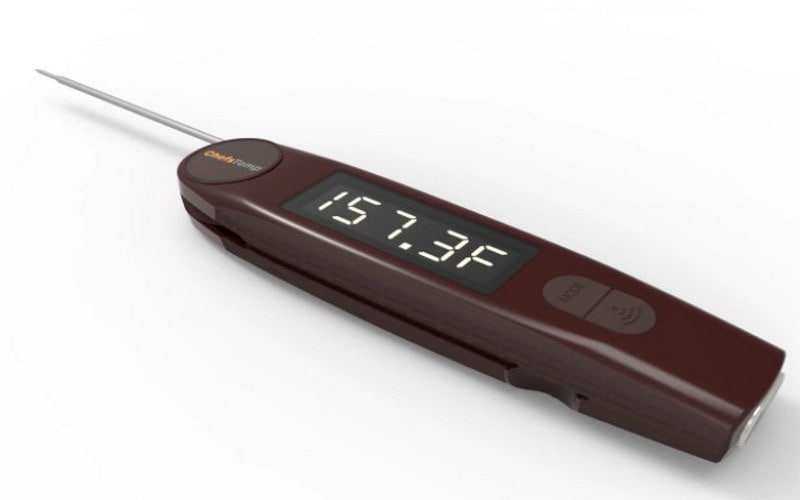
How to Insert a Meat Thermometer Into Turkey?
The food and feast are important components of every Thanksgiving celebration. There is one particular type of food that is never missing on the Thanksgiving table: turkey. However, a lot of people are intimidated to cook it knowing that it takes a lot of technique and finesse. Discover the basic cooking principles such as knowing where to place the thermometer in the turkey in order to get the best results.
Where to Place the Thermometer in Turkey?

This is one of the most common questions that people ask, especially those who are new to cooking turkey. Where is the best place to insert a thermometer in order to get the most accurate temperature reading in a turkey?
This is a legitimate concern: a turkey typically weighs 4 to 8 times more than an average whole chicken. Working with such a large piece of meat is not easy. It is easy to overcook the exterior and undercook the inside of the meat. Hence, you should never be without a thermometer when cooking turkey because it’s the only way you can ensure that the meat is done on the inside.
For this reason, you need to always have a meat thermometer in your kitchen. You will need it to guide you in cooking the perfect turkey, especially one that is delicious and still juicy.
The turkey is so big that the different parts will require different cooking temperatures. You must check at least two different areas of the meat to ensure ‘doneness’. Accurate probe placement of the thermometer is going to give you the best and most accurate reading results.
1. Breast
The breast is the first part of the turkey where you must in
sert the thermometer. The breast of a turkey is located on the upper portion of the bird near the neck. This part of the turkey is made up of thick and succulent meat. Thus, it is the best spot for temperature reading because it takes the longest to cook.
Another reason why the breast is the perfect spot to place your thermometer is that there is no bone in this area. The bone can cause inaccuracy in temperature reading with a thermometer.
2. Thigh
The thigh area is another recommended spot for the placement of your probe thermometer. Just like the breast, the thigh is one of the thickest parts of the bird as it consists of a lot of flesh and muscles.
Insert the probe into the deepest part of the thigh. Make sure to avoid the bone as it can distort your reading. For a reliable reading, the probe must be between the flesh and the bone.
Guidelines for Checking Turkey Temperature
Depending on the reading that you get from the thigh and the breast area of the turkey, you can adjust the temperature when cooking so that you don’t overcook one part of the turkey while the rest is undercooked. Based on your reading, you can either reduce (or increase) the cooking temperature or adjust which rack you place the turkey on.
As mentioned above, one of the things that make reading the turkey temperature tricky is the varying temperature gradient. Heat moves from the exterior of the turkey and makes its way into the inside. Therefore, it is common for the exterior to appear cooked yet for the inside of the meat to be raw. There is a huge difference between the interior and exterior temperature of the turkey.
For example, the higher the temperature you cook the turkey, the larger the temperature gradient inside of the meat. Knowing the concept of temperature gradient will help you better understand the importance of knowing where to place a thermometer in turkey.
Aside from the temperature gradient, it is also important to know the concept of a thermal center. The thermal center is any part of the meat that is farthest from the heat source – this would be the inside of the bird. This part will take the longest to cook given how thick the meat is.
In the case of turkey, the breast is the thickest part of the meat and is known as the thermal center. This explains why you need to insert the thermometer in the breast in order to check its temperature and make sure that it is cooked.
When using a thermometer to check the internal temperature of a turkey, it also pays to know the sensor location of the probe. This is critical in the accurate placement of the probe inside the meat and the accuracy of the reading that you get. Most sensors in a probe are located at the very tip. This is the part of the probe that you must target within the meat so that you can get the temperature reading right.

Cooking the Perfect Turkey
Knowing where to place a thermometer in turkey is only the first step in the process of cooking the perfect turkey. It is also important to get familiar with the type of thermometer you are using in order to achieve the ideal temperature of the meat.
If you have an oven-safe thermometer, you can insert it into the meat prior to putting it into the oven. This will allow you to monitor the temperature of the meat as it cooks. Even if you don’t have an oven-safe thermometer, you can check the internal temp with a thermometer from time to time.
You should aim for a temperature of 76 degrees C in the breast. If you are using an instant read thermometer, make sure to check the turkey’s temperature around 30 minutes to an hour before the completion of the estimated cook time. Then, make sure you check the turkey’s internal temp every 15 minutes until you reach the ideal temperature.
Remove the turkey from the oven as soon as the temperature reading is at 82 degrees C. If you leave the turkey in there for too long, it could become overcooked and dry when you serve it. This is why it is important to emphasize the need to constantly monitor and check the temperature as you cook the turkey.
One Comment
Comments are closed.
Discover Other ChefsTemp Products
Discover more recipes and learn kitchen tricks by joining our cooking family on Facebook.
You may also like:
















[…] the roasting temperature for your turkey breast remains the same, the cooking times might vary based on the turkey breast […]